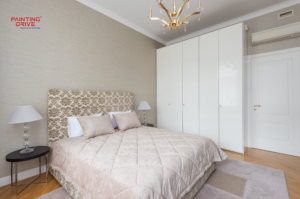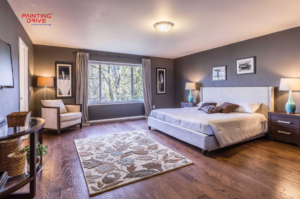Are you confused about choosing between texture paint and normal paint for your home? The right choice can elevate your space from tedious to impressive. Texture paint adds depth and character to walls, creating unique wall textures that resemble stucco and stone, hide imperfections, and provide a durable finish.
Normal paint provides a smooth, even finish in a variety of colors and is easier and more affordable to apply and maintain, though it may not conceal wall flaws as effectively.
If you want a decorative touch, go for the texture paint. For a classic, sleek finish, choose normal paint. Understanding these differences will help you make an informed decision for your space.
What is Texture Paint?
Texture paint is a type of paint that adds a three-dimensional appearance to walls and ceilings, creating patterns that range from subtle to dramatic. It can mimic materials like stone, brick, or stucco, adding depth and character to a space. Techniques like sponging, rag rolling, and troweling create unique finishes.
This paint hides wall imperfections like cracks and uneven surfaces, making it ideal for older homes. It offers a durable finish that resists chipping and peeling, preserving its appearance over time. While its application is more complex and costly, the aesthetic and practical benefits make it a valuable investment for enhancing interior design.

Advantages of Texture Paint
1. Aesthetic Appeal
Texture paint can transform a plain wall into a focal point with its rich, detailed patterns. It’s perfect for adding visual interest and a touch of sophistication to any room.
2. Hides Imperfections
If your walls have minor flaws such as cracks or uneven surfaces, texture paint can effectively camouflage these imperfections. The raised texture distracts the eye, making blemishes less noticeable.
3. Durability
Texture paint is typically more durable than normal paint. Its thicker consistency makes it resistant to chipping and peeling, which means it can last longer and maintain its appearance over time.
4. Variety of Designs
There are numerous techniques and tools available to create different textures, such as sponging, rag rolling, and troweling. This variety allows for a high level of customization to suit your style and the overall decor of your home.

Disadvantages of Texture Paint
1. Complex Application
Applying texture paint is more complicated and time-consuming than normal paint. It often requires special tools and a certain level of skill to achieve the desired effect. For best results, you might need to hire a professional.
2. Cost
Due to the specialised nature of texture paint and the labour intensive application process, it tends to be more expensive than normal paint. Both the paint itself and the cost of hiring a professional can add up.
3. Maintenance Challenges
Cleaning textured walls can be more difficult compared to smooth walls. Dust and dirt can get trapped in the crevices, requiring more effort to keep them looking fresh.
What is Normal Paint?
Normal paint, also known as regular or flat paint, is a versatile and commonly used type of paint that provides a smooth, even finish on walls and ceilings. It’s the standard choice for most interior and exterior painting projects due to its ease of application and cost-effectiveness. Normal paint comes in a wide range of colors, allowing for extensive customization to suit any design preference.it offers various finishes, such as matte, eggshell, satin, semi-gloss, and gloss, each offering varying degrees of sheen and durability.
Matte finishes give a soft, non-reflective appearance ideal for hiding imperfections, while glossier finishes add a sleek, polished look and are easier to clean. This adaptability makes normal paint a go-to option for both residential and commercial spaces, providing a reliable and attractive solution for any painting needs.

Advantages of Normal Paint
1. Ease of Application
Normal paint is straightforward to apply, making it a popular choice for DIY projects. With the right tools and a bit of practice, you can achieve a professional-looking finish without needing to hire an expert.
2. Cost-Effective
Generally, normal paint is more affordable than texture paint. Both the materials and the labor costs are lower, making it a budget-friendly option for large projects.
3. Versatility
With an extensive range of colors and finishes available, normal paint can suit any decor style. Whether you prefer a matte look for a cozy feel or a glossy finish for a sleek, modern appearance, there’s a normal paint option for you.
4. Easy Maintenance
Smooth walls painted with normal paint are easier to clean and maintain. Depending on the finish, many normal paints are washable, allowing you to remove stains and marks with a damp cloth.

Disadvantages of Normal Paint
1. Limited Visual Impact
While normal paint offers a wide variety of colors and finishes, it doesn’t provide the same level of visual interest as texture paint. If you’re looking to create a standout feature wall, normal paint might not deliver the dramatic effect you desire.
2. Doesn’t Hide Imperfections Well
Normal paint can highlight flaws on your walls, such as cracks, dents, or uneven surfaces. If your walls are less than perfect, you might need to spend extra time and effort on surface preparation to achieve a smooth finish.
3. Less Durable
Depending on the finish, normal paint can be less durable than texture paint. For example, flat and matte finishes tend to be more susceptible to staining and damage, whereas glossy finishes are more resistant but can show imperfections more easily.
Choosing Texture Paint vs Normal Paint for a Stunning Look
Choosing between texture paint and normal paint depends on several factors, including your budget, the condition of your walls, the look you want to achieve, and your willingness to maintain the painted surfaces.
Consider Texture Paint If
- You want to add a distinctive, decorative touch to your walls.
- Your walls have flaws that need to be hidden.
- You’re prepared to invest in professional application and maintenance.
- You’re looking for a durable finish that can withstand wear and tear.
Consider Normal Paint If
- You prefer a smooth, classic finish.
- You’re working with a limited budget.
- You plan to undertake a DIY painting project.
- You want easy-to-clean walls that require minimal maintenance.
How Painting Drive Can Help You with Painting Services
We understand the nuances of both texture and normal paint applications. Our team of experienced professionals can help you choose the best option for your home and ensure a flawless application, bringing your vision to life. Whether you want the intricate designs of texture paint or the sleek finish of normal paint, Painting Drive is here to transform your space with quality and expertise.
Conclusion
Both texture paint and normal paint have their own set of benefits and drawbacks. By understanding these differences, you can make an informed decision that best suits your needs and enhances the beauty of your home. Whether you opt for the striking depth of texture paint or the timeless simplicity of normal paint, a fresh coat of paint is sure to breathe new life into your space.
Ultimately, the choice between texture paint and normal paint comes down to your personal preferences, the specific requirements of your walls, and your vision for your home’s aesthetic. Take your time weigh the pros and cons, and don’t hesitate to seek professional advice to achieve the best outcome for your home.
At Painting Drive, we specialize in high-quality painting and wall painting and texture services. Our expert team can help you choose the best paint for your interior walls and ensure a flawless application. Contact us today to transform your home with our professional painting services.




